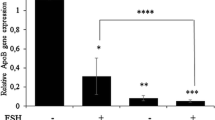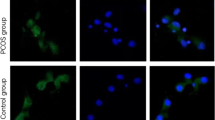Abstract
Purpose
To determine whether Aβ40 levels in the follicular fluid (FF) of infertile women undergoing IVF demonstrate a relationship with IVF cycle parameters and outcome.
Methods
FF Aβ40 levels were compared between patients achieving ongoing pregnancy and those with unsuccessful cycles. Clinical data such as ongoing pregnancy rate, implantation rate, number of oocytes retrieved, number of 8 cells embryos with ≤5 % fragmants, ratio of 8 cells embryos with ≤5 % fragmants to total embryos per patient and cleavage rate were compared among three percentile groups of Aβ40. CCK-8 method was used to measure the effect of Aβ40 on rat granulosa cells proliferation in vitro. RT-PCR was used to detect the mRNA expression levels of steroidogenesis related genes.
Results
Patients achieving ongoing pregnancy (n = 26; 50.98 %) demonstrated significantly higher FF Aβ40 levels compared to those with unsuccessful cycles (n = 25; 49.02 %; P = 0.024). No significant differences were observed in APP (amyloid precursor protein) and its other proteolysis products including sAPPα, sAPPβand Aβ 42 between the two groups. Statistically significant differences between the three percentile groups of Aβ 40 were observed only in the implantation rates and ongoing pregnancy rates. There were no statistically significant differences between the three percentile groups in the age, No. oocytes retrieved, No. 2 pronucleus, No. embryos transferred, No. 8 cells embryos with ≤5 % fragmants and cleavage rate. Significantly negative correlation exists between APP and AFC (antral follicle count) (R =−0.360, P = 0.005) and oocytes retrieved (R =−0.378, P = 0.004). There were also significantly positive correlations between Aβ40 and Aβ42 (R = 0.407, P = 0.000), between AFC and oocytes retrieved (R = 0.476, P = 0.000). Rat granulosa cells treated with Aβ40 of different concentrations have improved their proliferative ability. Cells treated with 200 pg/ml Aβ40 have the strongest ability of proliferation. 200 pg/ml Aβ40 enhanced the expression of key molecules during steroidogenesis such as IGF-1,IGF-1receptor (IGF-1R),FSH receptor (FSHR),P450 aromatase (P450arom),steroidogenic acute regulatory protein (StAR) and cholesterol side-chain cleavage cytochromes P450(P450scc).
Conclusions
Aβ40 levels in follicle fluid may be associated with ongoing pregnancy and the moderate expression level of Aβ40 is important for oocytes and embryos development.




Similar content being viewed by others
References
Checler F. Processing of the beta-amyloid precursor protein and its regulation in Alzheimer’s disease. J Neurochem. 1995;65:1431–44.
Selkoe DJ. Translating cell biology into therapeutic advances in Alzheimer’s disease. Nat. 1999;399:A23–31.
Whitson JS, Selkoe DJ, Cotman CW. Amyloid beta protein enhances the survival of hippocampal neurons in vitro. Sci. 1989;243:1488–90.
Mizoi M, Yoshida M, Saiki R, Waragai M, Uemura K, Akatsu H, et al. Distinction between mild cognitive impairment and Alzheimer’s disease by CSF amyloid β40 and β42, and protein-conjugated acrolein. Clin Chim Acta. 2014;430:150–5.
Freude KK, Penjwini M, Davis JL, LaFerla FM, Blurton-Jones M. Soluble amyloid precursor protein induces rapid neural differentiation of human embryonic stem cells. J Biol Chem. 2011;286(27):24264–74.
Hoe HS, Lee KJ, Carney RS, Lee J, Markova A, Lee JY, et al. Interaction of reelin with amyloid precursor protein promotes neurite outgrowth. J Neurosci. 2009;29:7459–73.
Siemes C, Quast T, Kummer C, Wehner S, Kirfel G, Müller U, et al. Keratinocytes from APP/APLP2-deficient mice are impaired in proliferation, adhesion and migration in vitro. Exp Cell Res. 2006;312(11):1939–49.
Young-Pearse TL, Chen AC, Chang R, Marquez C, Selkoe DJ. Secreted APP regulates the function of full-length APP in neurite outgrowth through interaction with integrin beta1. Neural Dev. 2008;3:15.
Kienlen-Campard P, Tasiaux B, Octave JN. The processing and biological function of the human amyloid precursor protein (APP): lessons from different cellular models. Exp Gerontol. 2000;35(6–7):843–50.
Li R, He P, Cui J, Staufenbiel M, Harada N, Shen Y. Brain endogenous estrogen levels determine responses to estrogen replacement therapy via regulation of BACE1 and NEP in female Alzheimer’s transgenic mice. Mol Neurobiol. 2013;47(3):857–67.
Kimura A, Kakinuma K, Yonezawa S, Takahashi T. Expression of β-amyloid precursor protein in the porcine ovary. Zool Sci. 2000;17(6):769–77.
Hartmann D, De Strooper B, Saftig P. Presenilin-1 deficiency leads to loss of Cajal-Retzius neurons and cortical dysplasia similar to human type 2 lissencephaly. Curr Biol. 1999;9:719–27.
Herms J, Anliker B, Heber S, Ring S, Fuhrmann M, Kretzschmar H, et al. Cortical dysplasia resembling human type 2 lissencephaly in mice lacking all three APP family members. EMBO J. 2004;23:4106–15.
Guenette S, Chang Y, Hiesberger T, Richardson JA, Eckman CB, Eckman EA, et al. Essential roles for the FE65 amyloid precursor protein-interacting proteins in brain development. EMBO J. 2006;25:420–31.
Giuffrida ML, Caraci F, Pignataro B, et al. Beta-amyloid monomers are neuroprotective. J Neurosci. 2009;29:10582–7.
Yankner BA, Duffy LK, Kirschner DA. Neurotrophic and neurotoxic effects of amyloid beta protein: reversal by tachykinin neuropeptides. Sci. 1990;250:279–82.
Huo S, Xu Z, Zhang X, Zhang J, Cui S. Testicular denervation in prepuberty rat inhibits seminiferous tubule development and spermatogenesis. J Reprod Dev. 2010;56(4):370–8.
Tomikawa J, Uenoyama Y, Ozawa M, Fukanuma T, Takase K, Goto T, et al. Tsukamura H. Epigenetic regulation of Kiss1 gene expression mediating estrogen-positive feedback action in the mouse brain. Proc Natl Acad Sci U S A. 2012;109(20):E1294–301.
Portelius E, Mattsson N, Andreasson U, Blennow K, Zetterberg H. Novel abeta isoforms in Alzheimer s disease -their role in diagnosis and treatment. Curr Pharm Des. 2011;17:2594–602.
Chen Y, Dong C. Abeta40 promotes neuronal cell fate in neural progenitor cells. Cell Death Differ. 2009;16:386–94.
Mattson MP, Cheng B, Culwell AR, Esch FS, Lieberburg I, Rydel RE. Evidence for excitoprotective and intraneuronal calcium-regulating roles for secreted forms of the beta-amyloid precursor protein. Neuron. 1993;10:243–54.
Rossner S, Ueberham U, Schliebs R, Perez-Polo JR, Bigl V. The regulation of amyloid precursor protein metabolism by cholinergic mechanisms and neurotrophin receptor signaling. Prog Neurobiol. 1998;56:541–69.
Oliver JE, Aitman TJ, Powell JF, Wilson CA, Clayton RN. Insulin-like growth factor I gene expression in the rat ovary is confined to the granulosa cells of developing follicles. Endocrinol. 1989;124(6):2671–9.
Davoren JB, Kasson BG, Li CH, Hsueh AJ. Specific insulin-like growth factor (IGF) I- and II-binding sites on rat granulosa cells: relation to IGF action. Endocrinol. 1986;119(5):2155–62.
Danilovich N, Javeshghani D, Xing W, Sairam MR. Endocrine alterations and signaling changes associated with declining ovarian function and advanced biological aging in follicle-stimulating hormone receptor haploinsufficient mice. Biol Reprod. 2002;67(2):370–8.
Adriaens I, Cortvrindt R, Smitz J. Differential FSH exposure in preantral follicle culture has marked effects on folliculogenesis and oocyte developmental competence. Hum Reprod. 2004;19(2):398–408.
Lin D, Sugawara T, Strauss JF, Clark BJ, Stocco DM, Saenger P, et al. Role of steroidogenic acute regulatory protein in adrenal and gonadal steroidogenesis. Sci. 1995;267(5205):1828–31.
Acknowledgments
Supported by Guangzhou Science and Technology Program projects in 2011 (2011 J4100001), National Natural Science Foundation of China in 2011 (81170574), National Natural Science Foundation of China in 2013 (31371517), Nanfang hospital high-level project matching funds in 2012 (G201206).
Author information
Authors and Affiliations
Corresponding author
Additional information
Capsule
Patients achieving ongoing pregnancy demonstrated significantly higher FF Aβ40 levels compared to those with unsuccessful cycles. Rat granulosa cells treated with Aβ40 have improved their proliferative ability and enhanced the expression of key molecules during steroidogenesis.
Rights and permissions
About this article
Cite this article
Duan, FH., Chen, SL., Chen, X. et al. Follicular fluid Aβ40 concentrations may be associated with ongoing pregnancy following in vitro fertilization. J Assist Reprod Genet 31, 1611–1620 (2014). https://doi.org/10.1007/s10815-014-0345-6
Received:
Accepted:
Published:
Issue Date:
DOI: https://doi.org/10.1007/s10815-014-0345-6




